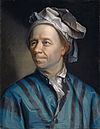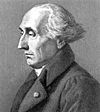Lagrange, Euler, and Kovalevskaya tops facts for kids
In classical mechanics, the precession of a rigid body such as a top under the influence of gravity is not, in general, an integrable problem. There are however three (or four) famous cases that are integrable, the Euler, the Lagrange, and the Kovalevskaya top. In addition to the energy, each of these tops involves three additional constants of motion that give rise to the integrability.
The Euler top describes a free top without any particular symmetry, moving in the absence of any external torque in which the fixed point is the center of gravity. The Lagrange top is a symmetric top, in which two moments of inertia are the same and the center of gravity lies on the symmetry axis. The Kovalevskaya top is a special symmetric top with a unique ratio of the moments of inertia which satisfy the relation
That is, two moments of inertia are equal, the third is half as large, and the center of gravity is located in the plane perpendicular to the symmetry axis (parallel to the plane of the two equal points). The nonholonomic Goryachev–Chaplygin top (introduced by D. Goryachev in 1900 and integrated by Sergey Chaplygin in 1948) is also integrable ( ). Its center of gravity lies in the equatorial plane. It has been proven that no other holonomic integrable tops exist .
). Its center of gravity lies in the equatorial plane. It has been proven that no other holonomic integrable tops exist .
Hamiltonian formulation of classical tops
A classical top is defined by three principal axes, defined by the three orthogonal vectors  ,
,  and
and  with corresponding moments of inertia
with corresponding moments of inertia  ,
,  and
and  . In a Hamiltonian formulation of classical tops, the conjugate dynamical variables are the components of the angular momentum vector
. In a Hamiltonian formulation of classical tops, the conjugate dynamical variables are the components of the angular momentum vector  along the principal axes
along the principal axes
and the z-components of the three principal axes,
The Poisson algebra of these variables is given by
If the position of the center of mass is given by  , then the Hamiltonian of a top is given by
, then the Hamiltonian of a top is given by
The equations of motion are then determined by
Euler top
The Euler top is an untorqued top, with Hamiltonian
The four constants of motion are the energy  and the three components of angular momentum in the lab frame,
and the three components of angular momentum in the lab frame,
Lagrange top
The Lagrange top (so named after Joseph-Louis Lagrange) is a symmetric top with the center of mass along the symmetry axis at location,  , with Hamiltonian
, with Hamiltonian
The four constants of motion are the energy  , the angular momentum component along the symmetry axis,
, the angular momentum component along the symmetry axis,  , the angular momentum in the z-direction
, the angular momentum in the z-direction
and the magnitude of the n-vector
Kovalevskaya top
The Kovalevskaya top is a symmetric top in which  ,
,  and the center of mass lies in the plane perpendicular to the symmetry axis
and the center of mass lies in the plane perpendicular to the symmetry axis  . It was discovered by Sofia Kovalevskaya in 1888 and presented in her paper "Sur le problème de la rotation d'un corps solide autour d'un point fixe", which won the Prix Bordin from the French Academy of Sciences in 1888. The Hamiltonian is
. It was discovered by Sofia Kovalevskaya in 1888 and presented in her paper "Sur le problème de la rotation d'un corps solide autour d'un point fixe", which won the Prix Bordin from the French Academy of Sciences in 1888. The Hamiltonian is
The four constants of motion are the energy  , the Kovalevskaya invariant
, the Kovalevskaya invariant
where the variables  are defined by
are defined by
the angular momentum component in the z-direction,
and the magnitude of the n-vector



















